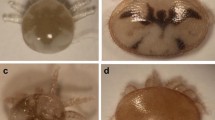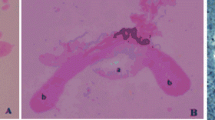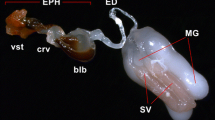Abstract
Mating of Varroa destructor takes place inside the sealed honey bee brood cell. During copulation, male mites transfer the spermatozoa into the genital openings of the females. Before the fertilization of female germ cells, the transferred spermatozoa have to pass through a final maturation process inside the genital tract of the female, the so-called capacitation. We here describe for the first time the morphological changes and chronological sequence of spermatozoa capacitation within female V. destructor. We have defined seven distinct stages of spermatozoa during the process of capacitation and have shown that it takes about 5 days from mating to the occurrence of spermatozoa ready for fertilization. This might explain the results of an additional experiment where we could show that freshly mated daughter mites need a phoretic phase on bees before their first reproduction cycle. The transfer of non-capacitated spermatozoa from male V. destructor and the resulting long capacitation period within the female mites seems to be a consequence of an adaptive pressure for the male mites to inseminate several daughter mites within the short time span inside the sealed honey bee brood cell.








Similar content being viewed by others
References
Akimov IA, Yastrebtsov AV (1984) Reproductive system of Varroa jacobsoni. I. Female reproductive system and oogenesis. Vestn zool 6:61–68 (in Russian with English abstract)
Akimov IA, Yastrebtsov AV, Gorgol VT (1988) Functional and morphological specialization of Varroa jacobsoni for parasitism. In: Bowman C (ed) Africanized honey bees and bee mites. Halsted Press, NY, ISBN 0-470-21113-X
Alberti G (1991) Spermatology in the Acari: systematic and functional implications. The Acari, pp 77–105. doi:10.1007/978-94-011-3102-5_6
Alberti G, Coons LB (1999) Acari—Mites. In: Harrison FW (ed) Microscopic anatomy of invertebrates, vol 8c. Wiley, New York, pp 515–1265
Alberti G, Hänel H (1986) Fine structure of the genital system in the bee parasite, Varroa jacobsoni (Gamasida: Dermanyssina) with remarks on spermiogenesis, spermatozoa and capacitation. Exp Appl Acarol 2:63–104
Alberti G, Michalik P (2004) Feinstrukturelle Aspekte der Fortpflanzungssysteme von Spinnentieren (Arachnida). Oberösterreichische Landesmuseen Neue Serie 14:1–62
Alberti G, Zeck-Kapp G (1986) The nutrimentary egg development of the mite, Varroa jacobsoni (Acari, Arachnida) an ectoparasite of honey bees. Acta Zool 67(1):11–25
Alberti G, Gegner A, Witaliñski W (2000) Fine structure of the spermatophore and spermatozoa in inseminated females of Pergamasus mites (Acari: Gamasida: Pergamasidae). J Morphol 245(1):1–18
Beetsma J, Zonneveld K (1992) Observations on the initiation and stimulation of oviposition of the Varroa mite. Exp Appl Acarol 16(4):303–312
Birk R (2015) Reproduktion von in vitro aufgezogenen unbegatteten Varroaweibchen (Varroa destructor), license thesis at the Faculty of Biology at the University of Hohenheim
Boot WJ, Calis JN, Beetsma J (1995) Does time spent on adult bees affect reproductive success of Varroa mites? Entomol Exp Appl 75(1):1–7
Bruce WA, Chiesa F, Marchetti S, Griffiths DA (1988) Laboratory feeding of Varroa jacobsoni Oudemans on natural and artificial diets (Acari: Varroidae). Apidologie 19(2):209–218
Calis JNM, Fries I, Ryrie SC (1999) Population modelling of Varroa jacobsoni Oud. Apidologie 30:111–124
De Ruijter A (1987) Reproduction of Varroa jacobsoni during successive brood cycles. Apidologie 18:321–326
De Ruijter A, Kaas JP (1983) The anatomy of the Varroa mite. Varroa jacobsoni oud affecting honey bees: present status and needs. AA Balkema, Rotterdam, pp 45–47
Dietemann V, Nazzi F, Martin SJ, Anderson DL, Locke B, Delaplane KS, Wauquiez Q, Tannahill C, Frey E, Ziegelmann B, Rosenkranz P, Ellis JD (2013) Standard methods for Varroa research. J Apicult Res 52(1). doi:10.3869/IBRA.1.52.1.09
Donzé G, Guerin PM (1994) Behavioral attributes and parental care of Varroa mites parasitizing honeybee brood. Behav Ecol Sociobiol 34:305–319
Donzé G, Guerin PM (1997) Time-activity budgets and space structuring by the different life stages of Varroa jacobsoni in capped brood of the honey bee, Apis mellifera. J Insect Behav 10(3):371–393
Donzé G, Herrmann M, Bachofen B, Guerin PM (1996) Effect of mating frequency and brood cell infestation rate on the reproductive success of the honeybee parasite Varroa jacobsoni. Ecol Entomol 21:17–26
Frey E, Odemer R, Blum T, Rosenkranz P (2013) Activation and interruption of the reproduction of Varroa destructor is triggered by host signals (Apis mellifera). J Invertebr Pathol 113(1):56–62
Fries I, Rosenkranz P (1996) Number of reproductive cycles of Varroa jacobsoni in honey-bee (Apis mellifera) colonies. Exp Appl Acarol 20(2):103–112
Fries I, Lindström A, Rosenkranz P, Frey E, Odemer R, Schroeder A, de Miranda JR, Yanez O, Paxton RJ (2011) The principal parasites and pathogenes of honeybees, Bees in Europe and Sustainable Honey Production, ISBN: 978-1-61209-336-9
Garrido C, Rosenkranz P (2003). The reproductive program of female Varroa destructor mites is triggered by its host, Apis mellifera. Exp Appl Acarol 31(3–4):269–273
Garrido C, Rosenkranz P, Paxton R, Gonçalves L (2003) Temporal changes in Varroa destructor fertility and haplotype in Brazil. Apidologie 34(6):535–541
Genersch E, Von der Ohe W, Kaatz H, Schroeder A, Otten C, Büchler R, Berg S, Ritter W, Mühlen W, Gisder S, Meixner M, Liebig G, Rosenkranz P (2010) The German bee monitoring project: a long term study to understand periodically high winter losses of honey bee colonies. Apidologie 41:332–352. doi:10.1051/apido/2010014
Häußermann CK, Ziegelmann B, Bergmann P, Rosenkranz P (2015) Male mites (Varroa destructor) perceive the female sex pheromone with the sensory pit organ on the front leg tarsi. Apidologie 46(6):771–778
Ifantidis MD (1983) Ontogenesis of the mite Varroa jacobsoni in worker and drone honey bee brood cells. J Apicult Res 22:200–206
Kuenen LPS, Calderone NW (1997) Transfers of Varroa mites from newly emerged bees: Preferences for age-and function-specific adult bees (Hymenoptera: Apidae). J. Insect Behav. 10(2):213–222
Le Conte Y, Ellis M, Ritter W (2010) Varroa mites and honey bee health: can Varroa explain part of the colony losses? Apidologie 41(3):353–365. doi:10.1051/apido/2010017
Martin SJ (1994) Ontogenesis of the mite Varroa jacobsoni Oud. In worker brood of the honeybee Apis mellifera L. under natural conditions. Exp Appl Acarol 18:87–100
Martin SJ (1995) Ontogenesis of the mite Varroa jacobsoni Oud. in drone brood of the honeybee Apis mellifera L. under natural conditions. Exp Appl Acarol 19:199–210
Martin S (1998) A population model for the ectoparasitic mite Varroa jacobsoni in honey bee (Apis mellifera) colonies. Ecol Model 109:267–281
Martin S, Holland K, Murray M (1997) Non-reproduction in the honeybee mite Varroa jacobsoni. Exp Appl Acarol 21(8):539–549
Moritz RFA, Mautz D (1990) Development of Varroa jacobsoni in colonies of Apis mellifera capensis and Apis mellifera carnica. Apidologie 21(1):53–58
Oliver JH (1989) Biology and systematics of ticks (Acari: Ixodida). Annu Rev Ecol Syst 20:397–430
Rehm SM, Ritter W (1989) Sequence of the sexes in the offspring of Varroa jacobsoni and the resulting consequences for the calculation of the developmental period. Apidologie 20(4):339–343
Ritter W (1981) Varroa disease of the honeybee Apis mellifera. Bee world 62(4):141–153
Rosenkranz P (1999) Honey bee (Apis mellifera L.) tolerance to Varroa jacobsoni Oud. in South America. Apidologie 30:159–172
Rosenkranz P, Engels W (1994) Infertility of Varroa jacobsoni females after invasion into Apis mellifera worker brood as a tolerance factor against varroatosis. Apidologie 25:402
Rosenkranz P, Aumeier P, Ziegelmann B (2010) Biology and control of Varroa destructor. J Invertrebr Pathol 103:96–119
Schmitt H (2013) Mating of the honey bee mite Varroa destructor: sperm maturation, time of sperm transfer and disturbance of sperm transfer through the application of sex pheromone components. Master thesis at the Apicultural State Institute of the University of Hohenheim, 31
Steiner J, Dittmann F, Rosenkranz P, Engels W (1994) The first gonocycle of the parasitic mite (Varroa jacobsoni) in relation to preimaginal development of its host, the honeybee (Apis mellifera carnica). Invertebr Rep Develop 25:175–183
Strauss U, Dietemann V, Human H, Crewe RM, Pirk CW (2015) Resistance rather than tolerance explains survival of savannah honeybees (Apis mellifera scutellata) to infestation by the parasitic mite Varroa destructor. Parasitology pp 1–14
Tabart J, Colin ME, Carayon JL, Tene N, Payre B, Vetillard A (2013) Artificial feeding of Varroa destructor through a chitosan membrane: a tool for studying the host-microparasite relationship. Exp Appl Acarol 61(1):107–118
Van der Zee R, Gray A, Pisa L, De Rijk T (2015) An observational study of honey bee colony winter losses and their association with Varroa destructor, neonicotinoids and other risk factors. PLoS ONE. doi:10.1371/journal.pone.0131611
Walter DE, Proctor HC (2013) Mites: ecology, evolution and behavior. Springer, New York. ISBN 978-94-007-7163-5
Young JH (1968) The morphology of Haemogamasus ambulans. II. Reproductive system (Acarina: Haemogamasidae). J Kansas Entomol Soc 41:532–542
Zeidl A (2015) Effekt einer unterschwelligen Applikation von Ameisensäure auf die Spermienübertragung bei der Bienenmilbe Varroa destructor. Bachelor thesis at the Apicultural State Institute of the University of Hohenheim
Ziegelmann B, Lindenmayer A, Steidle J, Rosenkranz P (2013a) The mating behavior of Varroa destructor is triggered by a female sex pheromone. Apidologie 44:314–323
Ziegelmann B, Tolasch T, Steidle JLM, Rosenkranz P (2013b) The mating behavior of Varroa destructor is triggered by a female sex pheromone. Part 2: identification and dose-dependent effects of components of the Varroa sex pheromone. Apidologie 44:481–490
Acknowledgments
We are grateful to Gerd Alberti (University Greifswald, Germany) for his helpful comments and Alice Guehennec for critical reading of the manuscript.
Author information
Authors and Affiliations
Corresponding author
Rights and permissions
About this article
Cite this article
Häußermann, C.K., Ziegelmann, B. & Rosenkranz, P. Spermatozoa capacitation in female Varroa destructor and its influence on the timing and success of female reproduction. Exp Appl Acarol 69, 371–387 (2016). https://doi.org/10.1007/s10493-016-0051-4
Received:
Accepted:
Published:
Issue Date:
DOI: https://doi.org/10.1007/s10493-016-0051-4




